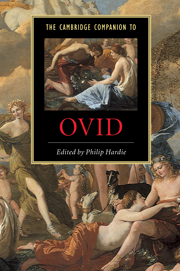Book contents
- Frontmatter
- Introduction
- Part 1 Contexts and history
- Part 2 Themes and works
- 5 Ovid and genre
- 6 Gender and sexuality
- 7 Myth in Ovid
- 8 Landscape with figures
- 9 Ovid and the discourses of love
- 10 Metamorphosis in the Metamorphoses
- 11 Narrative technique and narratology in the Metamorphoses
- 12 Mandati memores
- 13 Epistolarity
- 14 Ovid’s exile poetry
- Part 3 Reception
- Dateline
- Works cited
- Index
6 - Gender and sexuality
from Part 2 - Themes and works
Published online by Cambridge University Press: 28 May 2006
- Frontmatter
- Introduction
- Part 1 Contexts and history
- Part 2 Themes and works
- 5 Ovid and genre
- 6 Gender and sexuality
- 7 Myth in Ovid
- 8 Landscape with figures
- 9 Ovid and the discourses of love
- 10 Metamorphosis in the Metamorphoses
- 11 Narrative technique and narratology in the Metamorphoses
- 12 Mandati memores
- 13 Epistolarity
- 14 Ovid’s exile poetry
- Part 3 Reception
- Dateline
- Works cited
- Index
Summary
Ovid has been called sympathetic to women. While many modern feminists would be unhappy about this chivalric designation, there is no doubt that the Ovidian corpus provides a particularly rich site for gendered study. More than any other non-dramatic ancient poetry, male-authored as it overwhelmingly is, Ovid’s work gives space to a female voice, in however problematic a manner, and to both male and female voices which reflect explicitly on their own gendered identity. It is also driven by a troubled relationship with the purveyors of Roman masculinity - the army, politics, Augustus, epic, and so on. Moreover, the poet - par excellence - of the fluidity of identity clearly provokes a gendered reading.
Unstable categories
Although sexual identity, in its modern form of a choice between homosexuality and heterosexuality, is not the driving force of ancient constructions of personality, the development and maintenance of Gender was a major preoccupation. Engendering the self is as crucial as it is unstable in Ovid, poet of fluidity. The tidiest story of growing up to gendered identity is that of Iphis (Met. 9.666–797). Before her birth, her father instructed that the child should be killed if it were a girl, but her mother saved her, and brought her up as a boy. On reaching adolescence, she was due to be properly and respectably married to someone with whom she herself was in love.
- Type
- Chapter
- Information
- The Cambridge Companion to Ovid , pp. 95 - 107Publisher: Cambridge University PressPrint publication year: 2002
- 19
- Cited by



